AMD’s 5 GHz Turbo CPU in Retail: The FX-9590 and ASRock 990FX Extreme9 Review
by Ian Cutress on August 9, 2014 8:00 AM ESTCPU Benchmarks: Comparing Motherboards
Readers of our motherboard review section will have noted the trend in modern motherboards to implement a form of MultiCore Enhancement / Acceleration / Turbo (read our report here) on their motherboards. This does several things – better benchmark results at stock settings (not entirely needed if overclocking is an end-user goal), at the expense of heat and temperature, but also gives in essence an automatic overclock which may be against what the user wants. Our testing methodology is ‘out-of-the-box’, with the latest public BIOS installed and XMP enabled, and thus subject to the whims of this feature. It is ultimately up to the motherboard manufacturer to take this risk – and manufacturers taking risks in the setup is something they do on every product (think C-state settings, USB priority, DPC Latency / monitoring priority, memory subtimings at JEDEC). Processor speed change is part of that risk which is clearly visible, and ultimately if no overclocking is planned, some motherboards will affect how fast that shiny new processor goes and can be an important factor in the purchase.
Point Calculations – 3D Movement Algorithm Test: link
3DPM is a self-penned benchmark, taking basic 3D movement algorithms used in Brownian Motion simulations and testing them for speed. High floating point performance, MHz and IPC wins in the single thread version, whereas the multithread version has to handle the threads and loves more cores.
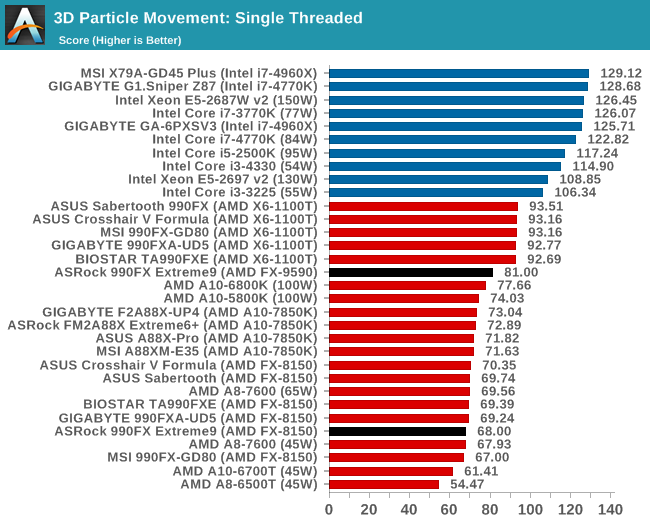

Compression – WinRAR 5.0.1: link
Our WinRAR test from 2013 is updated to the latest version of WinRAR at the start of 2014. We compress a set of 2867 files across 320 folders totaling 1.52 GB in size – 95% of these files are small typical website files, and the rest (90% of the size) are small 30 second 720p videos.
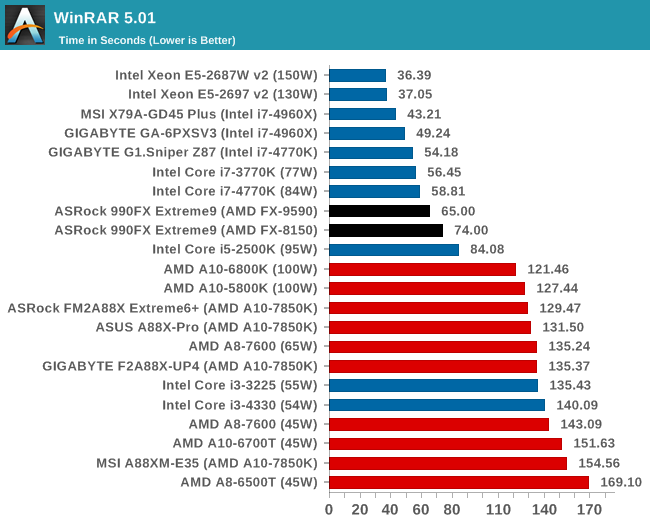
Image Manipulation – FastStone Image Viewer 4.9: link
FastStone is the program I use to perform quick or bulk actions on images, such as resizing, adjusting for color and cropping. In our test we take a series of 170 images in various sizes and formats and convert them all into 640x480 .gif files, maintaining the aspect ratio. FastStone does not use multithreading for this test, and results are given in seconds.
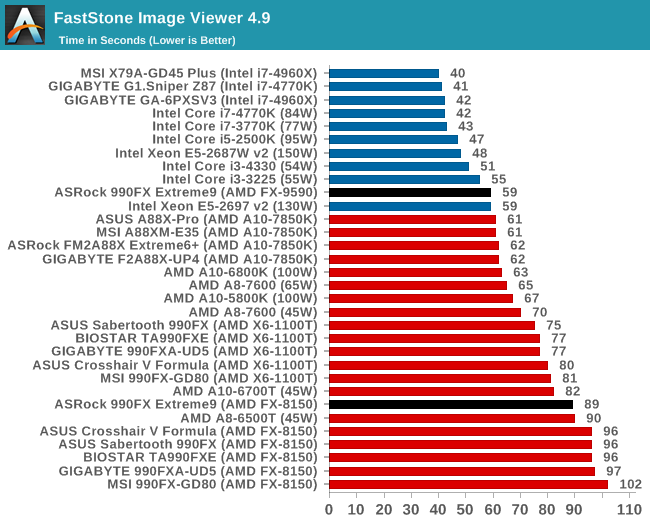
The FX-8150 result for the Extreme9 compared to other motherboards shows one of two things - the latest Windows SP1 with core parking updates has an effect, or the BIOS is more efficient at handling turbo modes than our older reviews.
Video Conversion – Handbrake v0.9.9: link
For HandBrake, we take two videos (a 2h20 640x266 DVD rip and a 10min double UHD 3840x4320 animation short) and convert them to x264 format in an MP4 container. Results are given in terms of the frames per second processed, and HandBrake uses as many threads as possible.
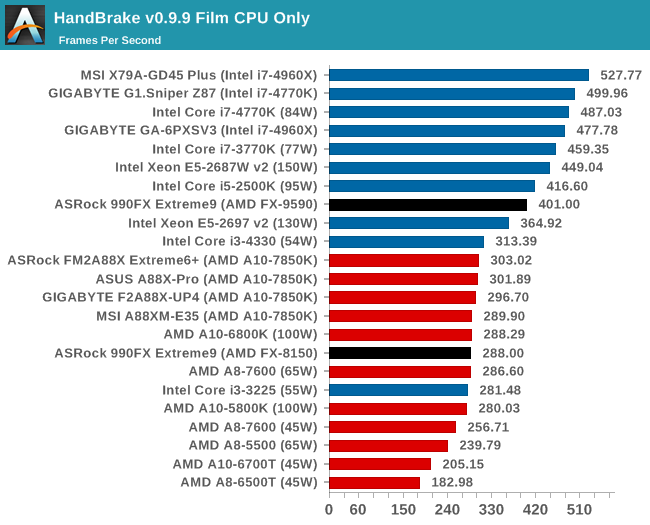

Rendering – PovRay 3.7: link
The Persistence of Vision RayTracer, or PovRay, is a freeware package for as the name suggests, ray tracing. It is a pure renderer, rather than modeling software, but the latest beta version contains a handy benchmark for stressing all processing threads on a platform. We have been using this test in motherboard reviews to test memory stability at various CPU speeds to good effect – if it passes the test, the IMC in the CPU is stable for a given CPU speed. As a CPU test, it runs for approximately 2-3 minutes on high end platforms.
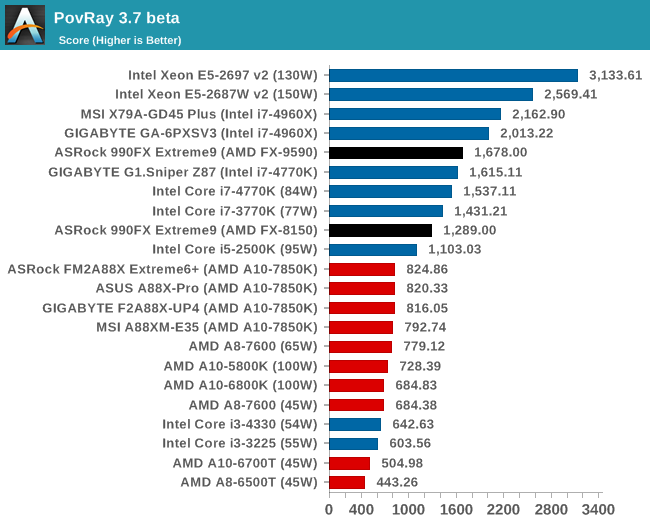
Synthetic – 7-Zip 9.2: link
As an open source compression tool, 7-Zip is a popular tool for making sets of files easier to handle and transfer. The software offers up its own benchmark, to which we report the result.
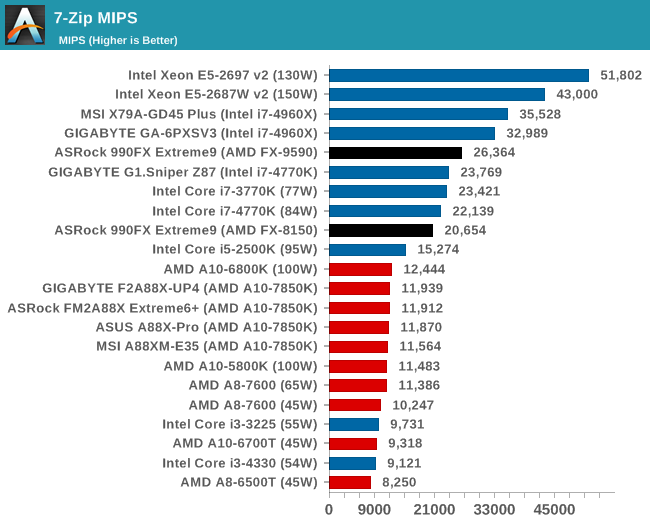










146 Comments
View All Comments
NeatOman - Saturday, August 9, 2014 - link
I have a FX-8320 @4.5Ghz, and never goes over 75c. I got it because it was $215 for both the CPU and a very good motherboard, and paired it with two HD 7850's. With that said, an overclocked i5@4.4Ghz is better then anything AMD can do over clocked even @5Ghz (for the most part) and at times far out classes it. But, an i5 and good motherboard will cost about $350 and $400+ for i7.. Almost twice. FYI, I live in Illinois and the electricity here is very very cheap.colinstu - Saturday, August 9, 2014 - link
a $300+ AMD chip?! LOL. Who the heck would buy this? It's not efficient, it's definitely not fast compared to $100 cheaper intel offerings (or similarly priced offerings in some of the other benches).swizeus - Saturday, August 9, 2014 - link
Second your opinion... It has been 3rd generation (or more ?) since FX gone out the door and AMD should have a solution to at least match Intel's performance by now, but why this ? It is pointless to have a power hungry beast that lost in the match with a processor that is halved in TDP in an Unzipping archive operation, not to mention electricity bill and the noise to cool down 220Watt TDP Processor... Not worth itRussianSensation - Sunday, August 10, 2014 - link
The amount of generations or the time span doesn't have any correlation with AMD catching up. Take an i7 4790K and manufacture it in 28-32nm node and see how awful it is. In other words, unless AMD can manufacture chips on the same node as Intel, it has no chance of competing whatsoever even if by magic their CPUs had identical IPC and clocks to Intel's. The delta in performance and performance/watt will only grow once Intel launches Skylake on 14nm next year.Budburnicus - Wednesday, March 11, 2015 - link
Umm a 4790K even at 32nm would still spank this chip across the board. How "awful" indeed...I mean forget the 4790K for a second, the 2600K at STOCK will beat this CPU out in nearly everything. and basically any i7-2600k on any board that supports overclocking WILL easily hit 4.2-4.4 - hell I had mine at 4.4 with a STOCK POS Intel Heatsink (POS in terms of its ability to cool, it is actually more than effective enough with how little heat the CPUs generate) - And at those speeds the 2600K beats out any and every AMD consumer CPU at almost everything, and what few benchmarks it will be behind in, it will not be by too much. And those benchmarks would include only VERY highly multithreaded applications of computational power - basically, server-type stuff. Certainly not in gaming!
Then there's the NEWER Intel CPUs like the i7-5930K (which I also own) which aren't too much more expensive than this flop, and will beat it out in absolutely anything and everything - at stock clocks again! With the exact same CoolerMaster Hyper 212 EVO I have on my i7-2600K machine (AWESOME cooler for the money, though I will probably replace the one currently on the 5930, as it does not provide the maximum OC headroom possible like it does on my 2600 machine) - with dual fans, I have all cores running totally stable at 4.4 GHz with 105.7 Bclock!
AMD really needs to dump this architecture for the consumer class entirely (though I admittedly am not too familiar with Server-class CPU benchmarks, from what I have read the newer Intel Xeon are spanking the current Opterons, but IIRC they still represent good value for money in the high end workstation and server classes - though Enthusiasts generally seem to stick with the Xeons as they like to be able to game at insane speeds and resolutions as well as do encoding, editing, CAD, etc. As I have seen quite a few "ULTIMATE Rig builds" where money is no issue, by people like NCIX, Linus Tech tips, PCper, and others on YouTube, but I have yet to see an ultimate Opteron machine)
So, yeah... All that speaks volumes to people who look at information objectively and without bias. IF AMD were to come out with a new chip tomorrow which not only spanked everything Intel has ever made, but also made it cheap like the original SandyBridge parts - and therefore changed the game, DAMNED right I would be coveting a brand new AMD rig, and would likely sell off my 2600K machine, despite my deep love for it (and the fact that it games slightly better than the 5930 due to higher core speeds by a decent bit) to try to fund such a build ASAP!
But as it is? You would have to be a blind fanboy to buy a CPU like this for a brand new build, as it does not perform well and eats power like crazy, requiring AMD to bundle a friggen AIO water-block with it! And even with the best of the best, it will BARELY overclock! So the stock speed benchmarks will never be too far from a sustainable, stable, overclock - a FAR different story from the i5-i7 2000-5000 K series CPUs - as I said, a pretty average overclock on an i7-2600K is 4.2 GHz, a full 1 GHz above stock speeds, as the 3.8 GHz turbo only works when a single core is under load, and even then it will still beat out tthis 5950 in most ways!
lurker22 - Saturday, August 9, 2014 - link
Is AMD even trying anymore? That power draw is PATHETIC in the year 2014xdrol - Saturday, August 9, 2014 - link
I think the fact that this very processor is still 'the' flagship shows that no, they are not even trying.TiGr1982 - Saturday, August 9, 2014 - link
No, they actually don't. This is just cherry-picked and overclocked FX-8350 from October 2012 with all the associated power draw and heat growing superlinearly because of the much higher operating voltage.However, AMD does develop their CPU side of the business, but since Kaveri this January the results go only into APUs (same will happen with Carrizo coming next year).
AMD APUs are actually very fine in their class, they are just in a shy situation regarding these factory overclocked 220W FXes. The rest of their lineup is fine.
StrangerGuy - Saturday, August 9, 2014 - link
300W alone for a CPU, holy mother of god. An entire Haswell gaming rig with 750 Ti would probably draw less power.BTW $250 is insane for any motherboard let alone an AMD one. That's an i5 4590 and a budget mobo right there already.
Daniel Egger - Saturday, August 9, 2014 - link
> 300W alone for a CPU, holy mother of god. An entire Haswell gaming rig with 750 Ti would probably draw less power.Don't know where you got that 300W from but yes, a decent Haswell system with 750 TI will not just probably but definitely draw less power than 300W. Mine takes around 35W idle and up to 120W in games.